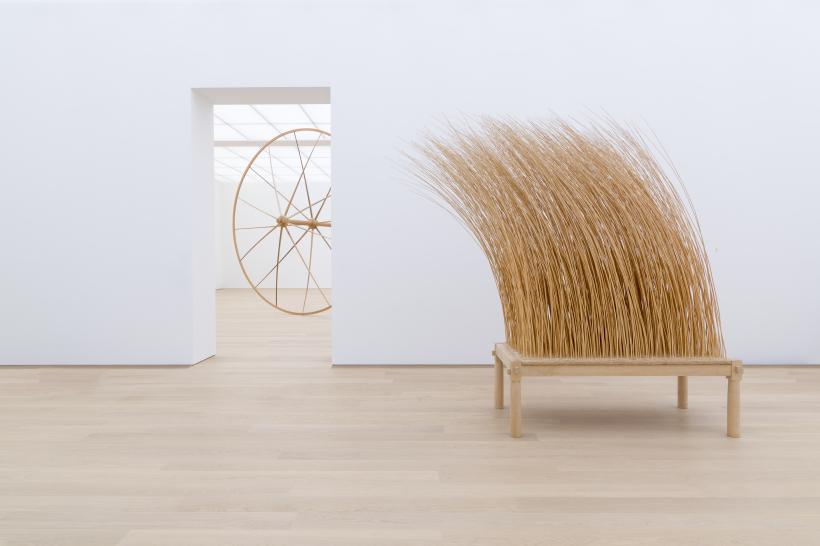Martin Puryear
Museum Voorlinden
20 January – 27 May, 2018
Review by John Gayer
Martin Puryear shapes dynamic structures that situate themselves somewhere between art and craft, allude to diverse sources and, despite his dedication to the use of wood, constitute a broad range of materials and techniques. Sidestepping affiliation with any particular movement or style, his art cannot be pigeonholed. At once highly evocative and immensely resolute, it clearly stands apart. Moreover, this self-titled exhibition, so elegantly installed in the Museum Voorlinden’s galleries, provides a concise and illuminating overview of his career produced between 1975 to the present, a momentous achievement, as Puryear’s output has received limited exposure in the Netherlands and ccording to his biography, his work last appeared in Amsterdam nearly 30 years ago.
The exhibition’s arrangement surprises and makes it a delight to behold. Whereas the first half of the presentation is dominated by polychromed sculptures, natural wood surfaces predominate in the second half. Another key feature of the layout is that it eschews a chronological ordering, which urges viewers to seek out aspects that highlight alternate paths of development. This makes a great deal of sense, as the progression of Puryear’s output tends to be more elliptical than linear. While an historical ordering would achieve factual accuracy, it would fail to convey the evocative resonances encompassed by his oeuvre.
One example of this eliptical progression pertains to the idea of tacking spherical entities onto the extremities of a work that crops up in a number of selections. Though the earliest appearance included here occurs in ‘untitled’ (1978), vestiges of the form can be spotted in ‘Some Tales’ (1975 - 1978), ‘Big and Little Same’ (1982), ‘Le Prix’ (2005), ‘Shell Game’ (2014) and ‘untitled’ (2017). The lattice offers a second, though less abundant, case. ‘Desire’ (1981) ‘Brunhilde’ (1998 - 2000), ‘C.F.A.O.’ (2006 - 2007) and ‘Frozen Dream’ (2018) all incorporate manifestations of this structure.
Puryear’s sculptures, moreover, attempt to thwart stasis by proposing multiple kinds of movement. Here, we have the arcing ‘Faux Vitrine’ (2014), the melting (or collapsing) ‘Question’ (2013 - 2014) and the impressive ‘Night Watch’ (2011), which offers a stunning depiction of wind blown grain. From a distance the manner in which the linear ‘Cascade’ (2013) and ‘untitled’ (2015), zip up, down and across the wall before looping back again intimates a track-like circuit. Moving closer to these works, then, introduces a cinematic cast. With the sheets of veneer out of which they are made in view, they suggest the frames of a film. The wheelbarrow carrying the outsized African headress in ‘C.F.A.O.’ doesn’t only appear to linger, it also wants to be used. The title, in fact, makes reference to Compagnie française de L’Afrique occidentale, a 19th century firm that conducted trade between Marseille and West Africa’s French colonies. Anther kind of portability is accentuated by the yurt depicted in ‘Frozen Dream’. Whereby the dwelling serves Mongolian nomads.
The final element that bolsters the potency of these works lies in their surface features. The sculptures produced out of natural wood possess an undeniable warmth and incredibly broad range of colours and textures. And when it comes to the use of colour, Puryear also handles it with a great deal of finesse. From the rich subtleties of ‘Shell Game’s mottled green skin and ‘Big Phrygian’s (2010 - 2014) intense red to the subdued black sheen of ‘Shackled’ (2014) and the ethereal glow that seeps out from behind ‘Cerulean’ (1982), there is much to behold. The surfaces can be so engrossing that it is possible to overlook the material basis of some compositions. The realisation that one has been looking at glass, cast iron or bronze may only surface later. I would advocate that lingering in the galleries be mandatory. Experiencing this exhibition should not be rushed.










